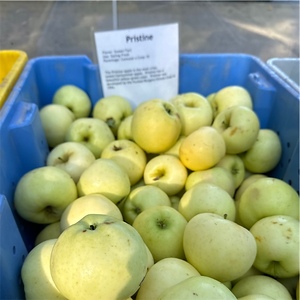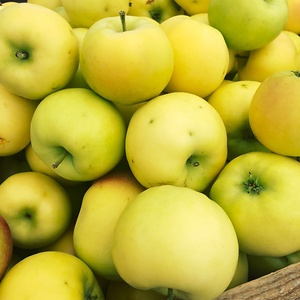


Pristine Apples
Estimated Inventory, lb : 0
Description/Taste
Pristine apples are round to oblate in shape, averaging 6 to 8 centimeters in diameter, and have a somewhat uniform appearance with light ribbing. The semi-thick skin is smooth, waxy, glossy, and green-yellow, ripening to a bright yellow when mature, and is sometimes spotted with faint, red-orange blush. Underneath the surface, the flesh is crisp, dense, pale yellow to ivory, and fine-grained, encasing a central core filled with a few black-brown seeds. Pristine apples have a balanced, sweet-tart flavor with light astringent notes of spice, banana, and green apple.
Seasons/Availability
Pristine apples are available in the mid-summer and can be stored through early fall.
Current Facts
Pristine apples, botanically classified as Malus domestica, are an early variety that belongs to the Rosaceae family. The sweet-tart fruit was intentionally created in the early 20th century as a summer variety that farmers could grow and sell before the maincrop season arrived. Before Pristine apples, early-season varieties were primarily tart fruits with a short shelf life. To change this reputation, Pristine apples were developed from multiple crosses to have extended storage capabilities and a sweeter flavor while being highly productive and resistant to disease. Pristine apples were initially known as Co-op 32, which was a name given to illustrate the cooperation that occurred during the creation of the variety between Indiana, New Jersey, and Illinois breeding stations. After the variety’s release to the market in the late 20th century, the apples were renamed to Pristine to showcase the fruit’s unblemished skin. Pristine apples were also named after the abbreviation PRI, which stands for the three breeding stations operating under Purdue, Rutgers, and the University of Illinois.
Nutritional Value
Pristine apples are a good source of vitamin C, which is an antioxidant that can help increase collagen production within the body and boost the immune system. The apples also provide fiber, which can stimulate the digestive tract, vitamin A, and potassium.
Applications
Pristine apples are best suited for both raw and cooked applications, such as baking and boiling. The fine-grained flesh can be consumed straight, out-of-hand, chopped into green and fruit salads, sliced and served with dips, blended into smoothies, or pressed into juices and ciders. The apples are also popularly cooked into applesauce, and once prepared, the sauce can be served with roasted meats, spread on toast, or swirled into oatmeal and yogurt. In addition to applesauce, Pristine apples can be sliced and baked in pies, tarts, cobblers, cakes, muffins, and bread. Pristine apples pair well with buckwheat honey, cinnamon, herbs such as thyme, sage, rosemary, and bay laurel, meats such as pork, poultry, and beef, sweet potato, chickpeas, goat cheese, cheddar, and mascarpone. The fresh fruits will keep 4-6 when stored whole and unwashed in a cool, dry, and dark place such as the refrigerator.
Ethnic/Cultural Info
Pristine apples were the eleventh variety to be created by the PRI Disease Resistant Apple Breeding Program, which is a joint breeding venture between the University of Illinois, Rutgers, and Purdue University. The cooperative was established in 1945 to create new and improved apple varieties that exhibit strong resistance to common diseases such as scab. Since its creation, the PRI program has created over 1,500 varieties and has selected 44 cultivars to be further researched and studied for market entry. Apples created by the program are labeled Co-op with a number to showcase the teamwork associated between the breeding stations. If the variety is released into the commercial market, the varieties are then renamed to appeal to the everyday consumer.
Geography/History
Pristine apples were developed by a cooperative breeding program known as PRI between agricultural experimental stations operating under Purdue, Rutgers, and the University of Illinois. This particular variety was bred in Indiana, developed from parent varieties camuzat and co-op 10, and was first selected for further study in 1982. Pristine apples were introduced to the market in 1994 where they received their current name, and today the variety is available through specialty grocers, farmer’s markets, and online seed catalogs for home garden use.
Recipe Ideas
Recipes that include Pristine Apples. One
| First & Full |
|
Cinnamon Apple Fries |
| Food From Portugal |
|
Apple, Honey and Cinnamon Pie |
| Every Last Bite |
|
Hasselback Baked Apples |










